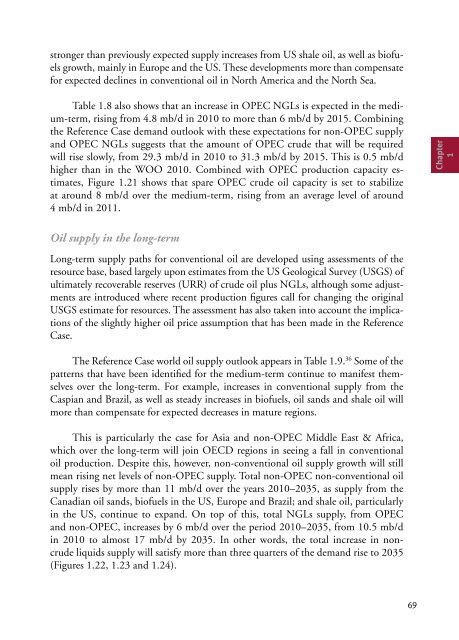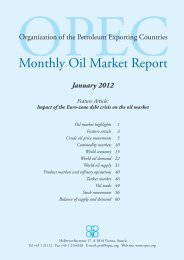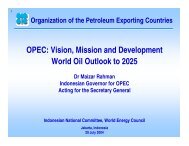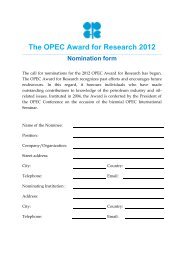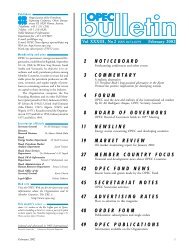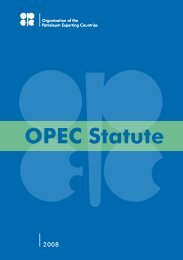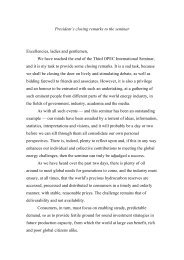Section One
Section One
Section One
You also want an ePaper? Increase the reach of your titles
YUMPU automatically turns print PDFs into web optimized ePapers that Google loves.
stronger than previously expected supply increases from US shale oil, as well as biofuels<br />
growth, mainly in Europe and the US. These developments more than compensate<br />
for expected declines in conventional oil in North America and the North Sea.<br />
Table 1.8 also shows that an increase in OPEC NGLs is expected in the medium-term,<br />
rising from 4.8 mb/d in 2010 to more than 6 mb/d by 2015. Combining<br />
the Reference Case demand outlook with these expectations for non-OPEC supply<br />
and OPEC NGLs suggests that the amount of OPEC crude that will be required<br />
will rise slowly, from 29.3 mb/d in 2010 to 31.3 mb/d by 2015. This is 0.5 mb/d<br />
higher than in the WOO 2010. Combined with OPEC production capacity estimates,<br />
Figure 1.21 shows that spare OPEC crude oil capacity is set to stabilize<br />
at around 8 mb/d over the medium-term, rising from an average level of around<br />
4 mb/d in 2011.<br />
Oil supply in the long-term<br />
Long-term supply paths for conventional oil are developed using assessments of the<br />
resource base, based largely upon estimates from the US Geological Survey (USGS) of<br />
ultimately recoverable reserves (URR) of crude oil plus NGLs, although some adjustments<br />
are introduced where recent production figures call for changing the original<br />
USGS estimate for resources. The assessment has also taken into account the implications<br />
of the slightly higher oil price assumption that has been made in the Reference<br />
Case.<br />
The Reference Case world oil supply outlook appears in Table 1.9. 36 Some of the<br />
patterns that have been identified for the medium-term continue to manifest themselves<br />
over the long-term. For example, increases in conventional supply from the<br />
Caspian and Brazil, as well as steady increases in biofuels, oil sands and shale oil will<br />
more than compensate for expected decreases in mature regions.<br />
This is particularly the case for Asia and non-OPEC Middle East & Africa,<br />
which over the long-term will join OECD regions in seeing a fall in conventional<br />
oil production. Despite this, however, non-conventional oil supply growth will still<br />
mean rising net levels of non-OPEC supply. Total non-OPEC non-conventional oil<br />
supply rises by more than 11 mb/d over the years 2010–2035, as supply from the<br />
Canadian oil sands, biofuels in the US, Europe and Brazil; and shale oil, particularly<br />
in the US, continue to expand. On top of this, total NGLs supply, from OPEC<br />
and non-OPEC, increases by 6 mb/d over the period 2010–2035, from 10.5 mb/d<br />
in 2010 to almost 17 mb/d by 2035. In other words, the total increase in noncrude<br />
liquids supply will satisfy more than three quarters of the demand rise to 2035<br />
(Figures 1.22, 1.23 and 1.24).<br />
69<br />
Chapter<br />
1


